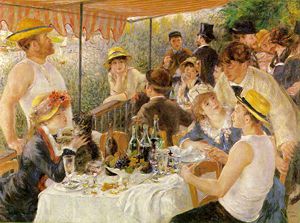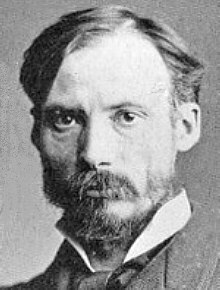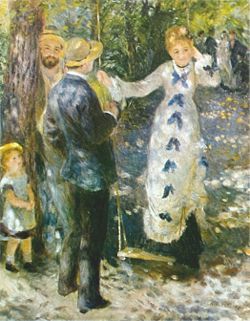Pierre-Auguste Renoir (February 25, 1841–December 3, 1919) was a French artist who was a leading figure in the development of the impressionist style. His early works were typically impressionist snapshots of real life, full of sparkling color and light. Characteristics of impressionist painting include visible brushstrokes, light colors, open composition, emphasis on light in its changing qualities (often accentuating the effects of the passage of time), ordinary subject matter, and unusual visual angles. The influence of impressionist thought spread beyond the art world. In all cases, the leading feature of impressionism is a break with a representational aesthetic, relying more on sense perception and conveying a more subjective art, reflecting the view of the artist, rather than an objective reality.
Biography
Pierre-Auguste Renoir was born in Limoges, Haute-Vienne, France, the child of a working class family. As a boy, he worked in a porcelain factory where his drawing talent led him to paint designs on china. He painted hangings for overseas missionaries, and painted on fans before he enrolled in art school. During those years, he often visited the Louvre to study the French master painters.
In 1862 he began studying art under Charles Gleyre in Paris. There he met Alfred Sisley, Frederic Bazille, and Claude Monet. At times during the 1860s, he did not have enough money to buy paint. Although Renoir first exhibited paintings in 1864, recognition did not come for another 10 years due, in part, to the turmoil of the Franco-Prussian War.
During the Paris Commune in 1871, while he painted by the Seine River, a Commune group thought he was spying and they were about to throw him in the river when a Commune leader, Raoul Rigault, recognized Renoir as the man who protected him on an earlier occasion and thus spared his life.
After many struggles in the beginning of his life, Renoir finally, in the mid-1870s, experienced his first acclaim when his work hung in the first impressionist exhibition of 1874.
While living and working in Montmartre, Renoir engaged in an affair with his model, Suzanne Valadon, who became one of the leading female artists of the day. But later, he married Aline Victorine Charigot, and they had three sons, one of whom, Jean Renoir, became a filmmaker. After his marriage, he was to paint many scenes of his children and their nurse.
In 1881 he traveled to Algeria, a country he associated with romantic painter, Eugène Delacroix, then to Madrid, Spain to see the well-known work of Diego Velázquez, also to Italy to see Titian's masterpieces in Florence, and the paintings of Raphael in Rome. Amidst all his travelling, Renoir painted Luncheon of the Boating Party the same year.
Luncheon of the Boating Party

|
| Le déjeuner des canotiers |
| Pierre-Auguste Renoir, 1880–1881 |
| oil on canvas |
| 129.5 × 172.7 cm |
| Phillips Collection |
Luncheon of the Boating Party, 1881, French: Le déjeuner des canotiers) is one of Renoir's masterpieces. The painting depicts a group of Renoir's friends relaxing on a balcony at the Maison Fournaise along the Seine river in Chatou, France. The painter and art patron, Gustave Caillebotte, is seated in the lower right. Renoir's future wife, Aline Charigot, is in the foreground playing with a small dog. In this painting Renoir has captured a great deal of light. The main focus of light is coming from the large opening in the balcony, beside the large singleted man in the hat. The singlets of both men in the foreground and the table-cloth both work together to reflect this light and send it through the whole composition. It is currently housed in the Phillips Collection in Washington, D.C.
Later life
On January 15, 1882, Renoir met composer Richard Wagner at his home in Palermo, Sicily. Renoir painted Wagner's portrait in just 35 minutes.
In 1883, he spent the summer in Guernsey, painting 15 paintings in little over a month. Most of these feature Moulin Huet, a bay in St. Martin's, Guernsey. These were the subject of a set of commemorative postage stamps, issued by the Bailiwick of Guernsey in 1983.
In 1887, a year when Queen Victoria celebrated her Golden Jubilee, upon the request of the queen's associate, Phillip Richbourg, Renoir donated several paintings to the "French Impressionist Paintings" catalog as a gift of his loyalty.
Around 1892, Renoir developed rheumatoid arthritis. In 1907, he moved to the warmer climate of "Les Collettes," a farm at Cagnes-sur-Mer, close to the Mediterranean coast. Renoir painted even during the last 20 years of his life when arthritis severely hampered his movement, and he was wheelchair-bound. He developed progressive deformities in his hands and ankylosis of his right shoulder, requiring him to adapt his painting technique. It is often said that in the advanced stages of his arthritis, he painted by strapping a brush to his arm, but other sources say that this is apocryphal. During this period, he created sculptures by directing an assistant who worked the clay. Renoir also utilized a moving canvas or picture roll to facilitate painting large works with his limited joint mobility.
Renoir visited the Louvre to see his paintings hanging with the old masters right before he died in the village of Cagnes-sur-Mer, Provence-Alpes-Côte d'Azur, on December 3, 1919.
Art
Renoir's paintings are notable for their vibrant light and color. Unlike many impressionists who focused on landscapes, he painted not only landscapes, but people in intimate and candid compositions, and made the female nude one of his primary subjects. In characteristic impressionist style, Renoir suggested the details of a scene through freely brushed touches of color, so that his figures softly fuse with one another and their surroundings.
His initial paintings show the influence of color in the works of Eugène Delacroix, the luminosity of Camille Corot, and the realism of Gustave Courbet and Édouard Manet. Another painter Renoir greatly admired was the eighteenth-century master François Boucher.
In the 1860s, through the practice of painting light and water en plein air (in the open air), he and his friend Claude Monet discovered that the color of shadows is not brown or black, but the reflected color of the objects surrounding them. Several pairs of paintings exist in which Renoir and Monet, working side-by-side, depicted the same scenes.
One of the best known impressionist works is Renoir's 1876 Dance at Le Moulin de la Galette (Le Bal au Moulin de la Galette), which depicts an open-air scene, jammed with people, in a popular dance garden on the Butte Montmartre close to where he lived.
A trip to Italy in 1881, where he saw works by Raphael and other Renaissance masters, convinced him that he was on the wrong path, and for the next several years he painted in a more severe style. This is sometimes called his "Ingres period," as he concentrated on his drawing and emphasized the outlines of figures. But after 1890 he again changed direction, returning to the use of thinly brushed color which dissolved outlines as in his earlier work. Starting from this period he concentrated especially on monumental nudes and domestic scenes.
Legacy
A prolific painter, Renoir made several thousand paintings. Unlike other famous impressionist paintings, Renoir’s earlier works contain figures that are easier to relate to, giving his works a more engaging quality. The warm sensuality of Renoir's style made his paintings some of the most well known and frequently reproduced works in the history of art.
Selected works
- Mademoiselle Romaine Lacaux (1864)
- La Promenade (1870)
- Monet Painting in His Garden at Argenteuil (1873)
- La Loge (1874)
- Woman with Fan (1875)
- The Swing (1876)
- Lunch at the Restaurant Fournaise (The Rowers' Lunch) (1875)
- Girl with a Watering Can (1876)
- Bal au moulin de la Galette, Montmartre (1876)
- Madame Charpentier and Her Children (1878)
- Jeanne Samary (1879)
- Acrobats at the Circus Fernando (1879)
- On the Terrace (1881)
- Luncheon of the Boating Party (1881)
- The Piazza San Marco, Venice (1881)
- Blonde Bather (1881)
- By the Seashore (1883)
- Umbrellas (1883)
- Dance at Bougival (1883)
- Fog at Guernsey (1883)
- Children on the Sea Shore in Guernsey (1883)
- The Bay of Moulin Huet Seen Through the Trees (1883)
- Girl with a Hoop (1885)
- Bathers (1887)
- The Bather (After the Bath (1888)
- In the Meadow (1890)
- The Apple Sellers (1890)
- Two Girls at the Piano (1892)
- Vase of Chrysanthemums (1895)
- Coco (1905)
- The Farm at Les Collettes, Cagnes (1908-1914)
- The Concert (1918)
ReferencesISBN links support NWE through referral fees
- Copplestone, Trewin. Pierre-Auguste Renoir (Treasures of Art). Grange Books, 1998. ISBN 1840131667
- Feist, Peter H. Pierre-Auguste Renoir 1841-1919: A Dream of Harmony. Taschen Books, 2000. ISBN 3822863289
- House, John. Pierre-Auguste Renoir: La Promenade, Los Angeles: J. Paul Getty Museum, 1997. ISBN 0892363657
External links
All links retrieved November 23, 2022.
- Renoir at biography.com
- Renoir at Olga's Gallery
- How Renoir Coped with Rheumatoid Arthritis article in British Medical Journal by Boonen A. et. al.
Credits
New World Encyclopedia writers and editors rewrote and completed the Wikipedia article in accordance with New World Encyclopedia standards. This article abides by terms of the Creative Commons CC-by-sa 3.0 License (CC-by-sa), which may be used and disseminated with proper attribution. Credit is due under the terms of this license that can reference both the New World Encyclopedia contributors and the selfless volunteer contributors of the Wikimedia Foundation. To cite this article click here for a list of acceptable citing formats.The history of earlier contributions by wikipedians is accessible to researchers here:
The history of this article since it was imported to New World Encyclopedia:
Note: Some restrictions may apply to use of individual images which are separately licensed.



